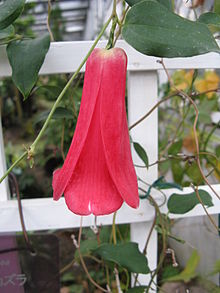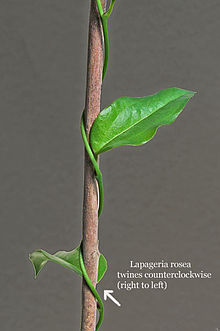- Lapageria rosea
-
Lapageria rosea
Copihue
Copihue in flower Scientific classification Kingdom: Plantae (unranked): Angiosperms (unranked): Monocots Order: Liliales Family: Philesiaceae Genus: Lapageria Species: L. rosea Binomial name Lapageria rosea
Ruiz & Pav.
Distribution area of Lapageria rosea Lapageria rosea, commonly known as the Copihue (co-pee-way < Mapudungun kopiwe)[1] or Chilean Bellflower, is the national flower of Chile. It grows in forests in the southern part of Chile, being part of the Valdivian temperate rain forests flora. It is the only species in the genus Lapageria.
Contents
Botany
Lapageria rosea is related to Philesia magellanica (syn. P. buxifolia), another plant from the Valdivian flora, closely related to L. rosea, having similar flowers, but is a shrubby plant bearing some similarity to a heath.[citation needed] ×Philageria veitchii is a hybrid between L. rosea and P. magellanica. It is more similar in appearance to the former.
Growth habit
It is an evergreen climbing plant reaching over 10 m high among shrubs and trees. Leaves are arranged alternately and are evergreen, leathery, lanceolate and feature three to seven prominent parallel veins. The vines twine counterclockwise in the Southern hemisphere and clockwise when grown in the Northern hemisphere (likely due to the Sun).
The flowers are red spotted with white, there are six thick, waxy tepals; and they are most frequently produced in late summer and fall, although they may be produced at other times. The fruit is an elongate berry with a tough skin containing numerous small seeds about the size of a tomato seed, and are covered in an edible fleshy aril. In the wild the plant is pollinated by hummingbirds.
Seed is distributed by birds and other animals.
Historical usage
In the past its fruit was sold in markets, but the plant has now become rare through over-collection and forest clearance.
The roots were once collected and used as a substitute for sarsaparilla. In 1977 the plant was given legal protection in Chile.
Common name etymology
The name of the fruit in Mapudungun is actually kopiw, which is the etymon of Spanish copihue; the Mapuche call the plant kolkopiw (colcopihue in Spanish, which may also refer to the whole plant). The flower is called kodkülla in the indigenous language.[1]
There are a substantial number of named garden cultivars, mostly developed at one nursery in Chile, with flower colour varying from deep red through pink to pure white (L. rosea 'Albiflora'), and some with variegated flowers. In cultivation, to obtain fruit it is generally necessary to pollinate by hand if there are not native hummingbirds.
Some cultivars are self-fruitful, but better pollination is achieved with differing parents. Germination is best with fresh moist seed; dried seeds take special treatment and have a much poorer germination rate[citation needed]. Propagation of cultivars is by cuttings (usually rooted under mist), layering, or division. Seedlings take from three to ten years to flower. Cuttings usually flower more quickly.
Mapuche legends
There are several legends in Chile relating to the origin of the Copihue. One tells of how, after a great battle of the Mapuche people, some survivors climbed trees to see the outcome of the battle. Seeing that all their friends were dead, they wept, and their tears became flowers of blood, to honor the souls of their dead friends.
Another legend tells of two Mapuche leaders: Hues, the daughter of Copiñiel, the leader of all Mapuches; and Copih, the chieftain of the Pehuenche tribe. The two young people secretly fell in love. One day, Copiñiel found them exchanging vows on the banks of the Nahuel lake, and, in a fit of rage, ordered them both stabbed through the heart by spears. His guards obeyed, and the two lovers were killed, fell into the lake, and disappeared in the water.
Some time later, both the Mapuche and Pehuenche tribes met on the banks of the lake to mourn the deaths of the two. At sunrise, they saw two spears rise from the water, intertwined by a vine, on which grew two large flowers, one as red as blood, and the other as white as snow. They called these flowers copihue, in honor of the two lovers, Copih and Hues.
Introduction to Europe
The plant was introduced to Europe by William Lobb during his plant collecting expedition to the Valdivian temperate rain forests in 1845–1848 and was growing at Kew in 1847.[2]
References
Bibliography
Bullard, A. J. – Master Gardener and grower of many species of fruit trees and vines including Lapageria rosea.
Crandall, Chuck and Crandall, Barbara 1995, Flowering, Fruiting & Foliage Vines: A Gardener Guide. Sterling Publishing Co. Inc., New York. ISBN 0806907266. Page 9 in the book illustrates clockwise and counterclockwise twining. Also see image on this webpage.
Grez, Audrey a., et al. - 'LANDSCAPE ECOLOGY, DEFORESTATION, AND FOREST FRAGMENTATION: THE CASE OF THE RUIL FOREST IN CHILE.'
Reed, Elbert E. - 'The Chilean Bellflower, Copihue, Lapageria rosea' California Horticultural Society Journal - July, 1964, Vol. XXV, No. 3
Song, Leo - 'Lapageria rosea, La Flor Nacional de Chile' - Cal. State Fullerton
Riedemann, Paulina & Aldunate, Gustavo - Flora Nativa de Valor Ornamental, Chile, zona sur ISBN 956-13-1827-X
Ruiz, Hippolyto & Pavon, Josepho - 'Flora Peruviana et Chilensis' 1802
External links
Categories:- Liliales genera
- Flora of Chile
- Symbols of Chile
- Plants and pollinators
- Pollination management
- Garden plants of South America
- Plants of mild maritime climate
Wikimedia Foundation. 2010.

